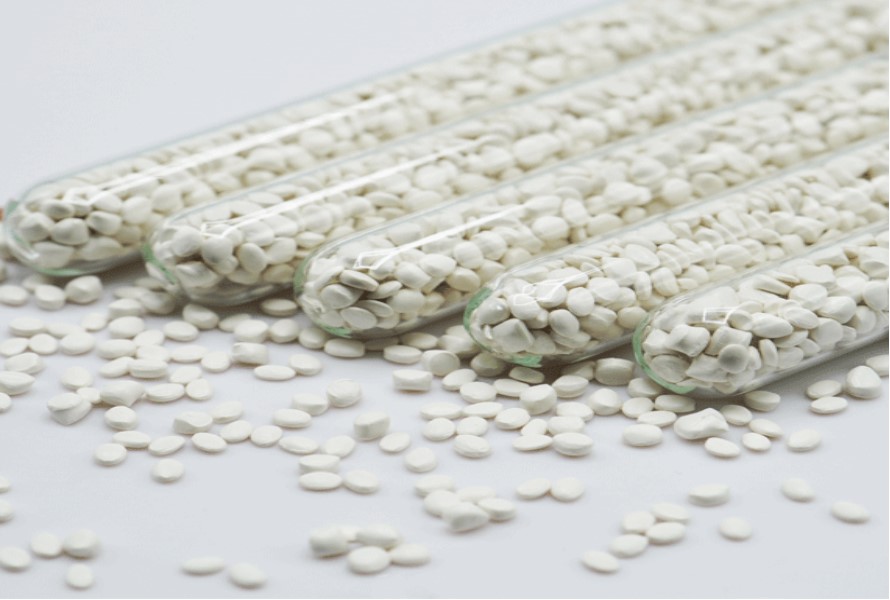Some polymers can easily burn and release flammable gasses, leading to a big fire. That's why flame retardant additives can be added to plastics to prevent ignition events from growing into larger fires. Since the substance can suppress or restrict combustion, it gives people more time to evacuate and firefighters more time to respond.
A wide range of plastics added with this additive offers satisfaction in end-product colors, functions, and safety. Let's scroll down to learn more in detail!
Read more:
1. Types of Flame Retardant Additives
Flame retardant additives are diverse in their chemical and physical properties.

The most common types include the following:
- Halogenated flame retardants: Halogenated flame retardant additives such as chlorine and bromine, are used for various plastics and textiles. They are composed of one carbon atom bonded to one halogen atom.
When these substances ignite, halogen radicals are released, which disrupts the chemical reactions that occur during burns. Their common applications include printed circuit boards and plastic housings for electrical and electronic components.
Even though these flame retardants are good at putting out flames, some people are concerned about their possible effects on the environment and human health.
- Phosphorus flame retardants: Phosphorus is a crucial component in the synthesis of flame retardants, which are used in polyurethane foams, electronics, PVC, high-temperature plastics, and casings made of less flammable plastics.
These flame retardant additives work by diluting flammable gasses, enhancing char production, and creating a protective coating on the material's surface. Despite being less effective than halogenated flame retardants, this option is more common for fire-resistant materials since they are considered safer and more eco-friendly.
- Nitrogen-based flame retardants: Many items, including nylons, polyolefins, polyurethane foams, fire-resistant paints, fabrics, and wallpapers, contain nitrogen-based flame retardants.
When they come into contact with high temperatures, they emit nitrogen gasses that dilute the oxygen concentration, prevent burning, and encourage the creation of protective char layers.
- Inorganic flame retardants and mineral compounds: When combined with nitrogen, phosphorus, or bromine, inorganic and mineral compounds are utilized as flame retardants or components in flame retardant systems.
Mineral compounds include phosphates, metal hydroxides, oxides, and metal products like magnesium, zinc, and aluminum, while inorganic compounds consist of nitrogen-based materials like graphite, silica, and inorganic phosphates. These substances aid in achieving fire safety in wood, textile, foam, and plastic items.
Mineral fillers, such as magnesium hydroxide and alumina trihydrate, function as physical barriers by cooling the material and lowering flammability through the emission of water vapor when heated.
- Intumescent flame retardants: These flame retardant additives include acid, carbon, and blowing agents which are used in intumescent systems. They are heated to create a protective char layer that insulates the material and stops it from burning any further.
2. Selection Criteria of Flame Retardant Additives
Engineers need to consider the selection criteria before choosing the proper flame retardant additives that meet a specific application's requirement.
- Quality requirements: Verify that its mechanical, thermal, and electrical characteristics meet the requirements of the application.
- Emission or migration: Under certain circumstances, some flame retardants migrate or vaporize out of the material.
- Side effects: The benefits of flame retardants, including enhanced fire safety, can also come with drawbacks. Selecting the best flame retardant for the specific application with consideration about its side effects can improve the overall plastic recipe.
- Possible impact on the environment: The environmental impact of the selected flame retardant, especially in eco-friendly applications, may include the generation of hazardous fire gasses, the requirement for additional processing for halogenated products, and the release of toxic breakdown products during recycling or disposal.
- Cost: Manufacturers also should consider the cost of flame retardant additives to monitor the budget for the whole manufacturing process.
3. Applications
Flame retardant additives are necessary to provide fire safety in a variety of products, including electronics, construction materials, furniture, and transportation. Their fire safety and health protection may reduce property damage and save lives.

- Electronics and electrical devices: These devices, such as computers and televisions, can only meet fire safety regulations with the use of flame retardants. Flame retardants are crucial for lowering the risk of fire by preventing short circuits and component overheating.
- Construction materials: flame retardant additives are incorporated into a variety of construction materials, such as fabrics, furniture, and insulation, to improve fire safety. These substances aid in controlling fires by delaying their spread, thus giving people crucial time to escape and shielding buildings from severe damage.
- Furnishings: Mattresses and upholstered furniture frequently get burned first in a fire. By adding flame retardants to the fibers and the filling of these products, fire resistance can be greatly increased, allowing occupants to leave safely with more time.
- Transportation: Travelers are greatly protected from fire-related risks by the use of flame retardant additives. These substances are utilized in a variety of materials on trains, automobiles, and airplanes to guarantee passenger safety.
4. Conclusion
Flame retardant additives have the ability to delay burning during the fire's ignition phase. Thus, they are applied to plastics and other materials to prevent, reduce, or delay burning situations.
Since these substances come in various types, it's important to consider the final products' requirements and other criteria to find the most suitable one.
5. About EuroPlas' flame retardant additive
Flame retardant additives are essential safety materials used in transportation, building, houseware, and electronic industries to prevent human injury or death and protect property from fire damage.

EuroPlas flame retardants offer high-impact properties, thermal and dimensional stability, and good scratch resistance. They follow the UL 94: V0, V1, và V2 standard, ensuring quality for use and processing. Our flame retardants limit fire spread and have good dispersion with standard resin. Plus, they do not cause mechanical degradation to end-products and equipment corrosion.
Contact EuroPlas right now for the best price!